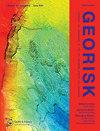软粘土速率相关行为的高保真度数据驱动建模
IF 4.8
3区 工程技术
Q1 ENGINEERING, GEOLOGICAL
Georisk-Assessment and Management of Risk for Engineered Systems and Geohazards
Pub Date : 2022-11-29
DOI:10.1080/17499518.2022.2149815
引用次数: 2
摘要
传统的现象学弹粘塑性模型包括许多需要通过具体案例实验校准的参数。数据驱动的建模最近出现,并提供了本构建模的替代方案。本研究提出了一个基于多保真度数据的建模框架来模拟软粘土的速率依赖行为。在这个框架中,弹粘塑性模型生成的低保真(LF)数据和实验测试的高保真(HF)数据是必要的。LF和HF数据背后的应力-应变-应变率相关性可以分别被长短期记忆和前馈神经网络捕获,这样最终的预测可以由多保真度残差神经网络(MR-NN)给出。在香港海相沉积物和Merville粘土中应用了相同LF数据的框架,以研究其可行性和推广能力。此外,讨论了LF数据对核磁共振神经网络性能的影响,验证了框架的鲁棒性。所有结果表明,该框架可以准确地模拟速率相关的不排水剪切强度和孔隙水压力,具有自适应非线性建模能力,对实验数据的需求较少,具有较好的鲁棒性。这些特征表明,在模拟粘土的速率依赖行为方面具有相当大的潜力。本文章由计算机程序翻译,如有差异,请以英文原文为准。
Multi-fidelity data-driven modelling of rate-dependent behaviour of soft clays
ABSTRACT Conventional phenomenological elasto-viscoplastic models include numerous parameters that need to be calibrated by case-specific experiments. Data-driven modelling has recently emerged and provided an alternative to constitutive modelling. This study proposes a modelling framework based on multi-fidelity data to model the rate-dependent behaviour of soft clays. In this framework, low-fidelity (LF) data generated by an elasto-viscoplastic model and high-fidelity (HF) data from experimental tests are necessary. Stress–strain-strain rate correlations behind LF and HF data can be captured by long short-term memory and feedforward neural networks, respectively, such that final predictions can be given by a multi-fidelity residual neural network (MR-NN). Such a framework with the same LF data is applied in Hong Kong marine deposits and Merville clay to investigate its feasibility and generalisation ability. In addition, the effect of LF data on the performance of MR-NN is discussed to verify the robustness of the framework. All results demonstrate that rate-dependent undrained shear strength and pore-water pressure can be accurately modelled through the framework, showing adaptive non-linear modelling capability, less demand for experimental data, and superior robustness. These characteristics indicate a considerable potential in modelling the rate-dependent behaviour of clays.
求助全文
通过发布文献求助,成功后即可免费获取论文全文。
去求助
来源期刊
CiteScore
8.70
自引率
10.40%
发文量
31
期刊介绍:
Georisk covers many diversified but interlinked areas of active research and practice, such as geohazards (earthquakes, landslides, avalanches, rockfalls, tsunamis, etc.), safety of engineered systems (dams, buildings, offshore structures, lifelines, etc.), environmental risk, seismic risk, reliability-based design and code calibration, geostatistics, decision analyses, structural reliability, maintenance and life cycle performance, risk and vulnerability, hazard mapping, loss assessment (economic, social, environmental, etc.), GIS databases, remote sensing, and many other related disciplines. The underlying theme is that uncertainties associated with geomaterials (soils, rocks), geologic processes, and possible subsequent treatments, are usually large and complex and these uncertainties play an indispensable role in the risk assessment and management of engineered and natural systems. Significant theoretical and practical challenges remain on quantifying these uncertainties and developing defensible risk management methodologies that are acceptable to decision makers and stakeholders. Many opportunities to leverage on the rapid advancement in Bayesian analysis, machine learning, artificial intelligence, and other data-driven methods also exist, which can greatly enhance our decision-making abilities. The basic goal of this international peer-reviewed journal is to provide a multi-disciplinary scientific forum for cross fertilization of ideas between interested parties working on various aspects of georisk to advance the state-of-the-art and the state-of-the-practice.

 求助内容:
求助内容: 应助结果提醒方式:
应助结果提醒方式:


